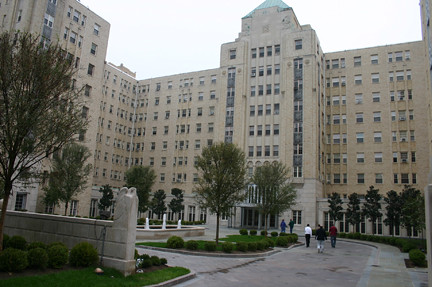More on design review
 Kennedy Warren Apartments on Connecticut Avenue NW, Washington DC. The building was only partially completed. It was started just before the Depression and so they didn't finish it. The building was expanded, completing the original design, last decade.
Kennedy Warren Apartments on Connecticut Avenue NW, Washington DC. The building was only partially completed. It was started just before the Depression and so they didn't finish it. The building was expanded, completing the original design, last decade.1. I had this letter to the editor in last week's (July 10th) Northwest Current about Councilmember Cheh's legislation to extend large tract review requirements to housing developments. My point is that the LTR regulation has no teeth, and without the provision of additional "remedies" that can bring about necessary changes, a change to the law is meaningless.
-------
The Current’s June 19 issue reports on legislation to tweak the large-tract review process in response to concern that it fails to give the public the opportunity to weigh in and receive a response concerning large matter-of-right housing developments, such as the Cafritz apartment building project on Connecticut Avenue.
New real estate developments shape our neighborhoods and the city for decades and generations, so it is incumbent on us to get them right at the outset. For the legislation to have any impact, it would need to provide "remedies" and procedures that create an opportunity to change a project when it would be worthwhile and in our best interest to do so.
But the large-tract review process does not do this now. It is not an approval or disapproval process. It merely creates an additional level of interagency review, to ensure that substantive matters are not overlooked in matter-of-right projects. Only in one instance -- if the zoning is judged to be out of sorts with the Comprehensive Plan -- does the regulation provide an ability to stop a project. Otherwise, the project sails through, subject to the possibility of tweaks -- if the developer is amenable, as the process doesn't require the developer to respond to citizen input.
In 2011, when Advisory Neighborhood Commission 4B submitted a detailed response concerning the large-tract review application for the Walmart project on Georgia Avenue (ANC4B Large Tract Review Report on Walmart, 5/2011), the Office of Planning and Department of Transportation for the most part ignored every recommendation. The agencies did not even raise the ideas offered with their bosses (the elected officials, who for the most part wanted the path for Walmart to be smooth and easy), the developer (Foulger-Pratt) or the tenant (Walmart).

Right: rendering of the apartment building to be constructed by Calvin Cafritz Enterprises on upper Connecticut Avenue NW in the Chevy Chase neighborhood.
Furthermore, while the regulation calls for minimizing "adverse environmental, traffic and neighborhood impacts," the Office of Planning ruled that "economic impact" was not a "neighborhood impact" that needed to be addressed or mitigated. (This ruling should be challenged and/or litigated, as it appears to be counter to the intent of the regulation.)
All too many gaps in the building regulation process impede input from citizens, advisory neighborhood commissions and other stakeholders that is particularly desirable in the center-city context, especially as the city is in a growth phase. Long after the developers have sold off these projects, residents will be living with the results -- for good and bad.
Sadly, this bill does not provide the remedies and procedures needed to ensure the kinds of positive outcomes from new real estate development projects that we should be seeking as stewards of the city's present and future.
-------------
2. In the thread on this topic from the other day, I mentioned that a couple weeks ago, there was a session on design review on the local NPR radio station's Kojo Nnamdi Show. It featured Tom Luebke, director of the US Commission on Fine Arts, which does design review for DC's monumental core and certain other public buildings, and Roger Lewis. Lewis is an architect and columnist for the Washington Post, but is also on the design review board in Alexandria, and Mr. Luebke had been the director for that board.
Lewis makes the point that to do design review you start with a plan, which should include design guidelines.
It's worth listening to the show.
Labels: architecture, civic engagement, historic preservation, neighborhood planning, planning, real estate development, urban design/placemaking, urban revitalization, zoning



0 Comments:
Post a Comment
<< Home